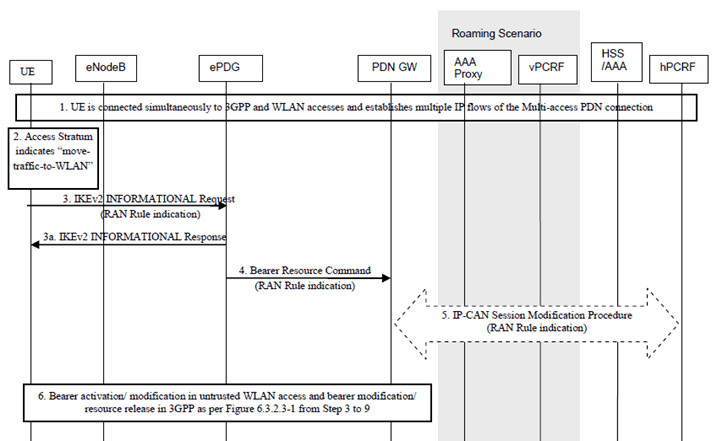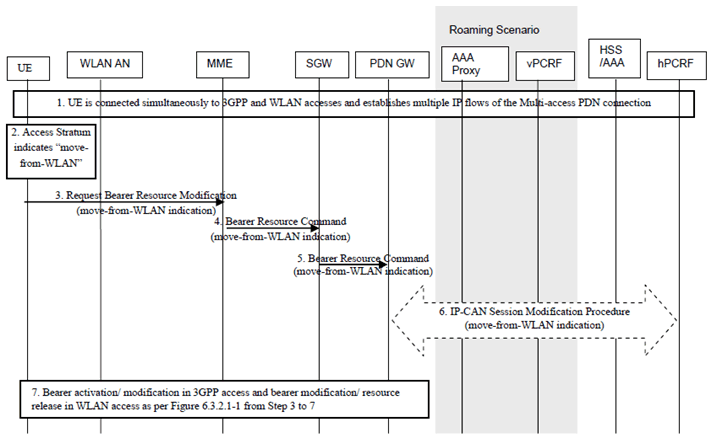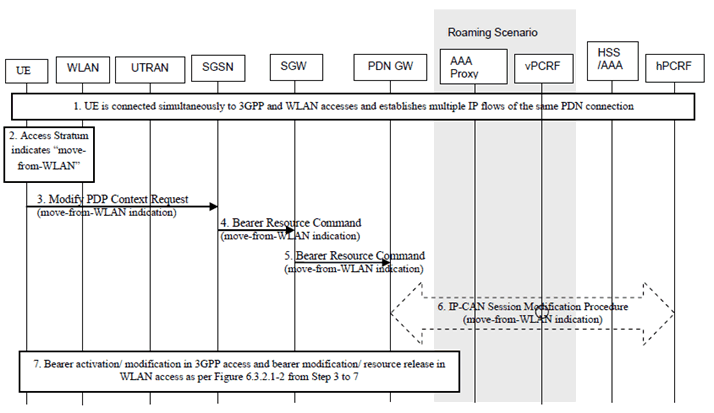Content for TS 23.161 Word version: 18.0.0
1…
5…
6…
6.2…
6.2.4
6.3…
6.3.2.2…
6.3.3…
6.3.3.2…
6.4…
6.4.2.2…
6.5…
6.5.2…
6.5.3…
6.6…
6.6.1.3…
6.6.2…
6.7…
6.7.2…
6.8…
6.7.2 IP flow mobility triggered by Access Stratum indication move-to-WLAN in Untrusted WLAN access
6.7.3 IP flow mobility triggered by indication move-from-WLAN
6.7.2 IP flow mobility triggered by Access Stratum indication move-to-WLAN in Untrusted WLAN access p. 61
The procedure is used in Network-initiated NBIFOM mode when the UE applies RAN-assisted WLAN interworking (i.e. RAN Rules) or RCLWI, and the Access Stratum indicates that the UE shall move traffic to WLAN when the UE is connected simultaneously to 3GPP and untrusted WLAN access.

Figure 6.7.2-1: Procedure for Access Stratum indication move-to-WLAN for GTP S2b
(⇒ copy of original 3GPP image)
(⇒ copy of original 3GPP image)
Step 1.
The UE is connected simultaneously to 3GPP and untrusted WLAN accesses.
Step 2.
Access Stratum indicates move-traffic-to-WLAN. If, based on clause 5.4, the UE determines for non-radio related reasons that the WLAN access cannot be used, steps 3 to 6 are not performed.
Step 3.
The UE sends the IKEv2 INFORMATIONAL Request message including a move-to-WLAN indication.
Step 3a.
The ePDG sends an IKEv2 INFORMATIONAL Response message to the UE.
Step 4.
The ePDG sends the indication to the PDN GW within a Bearer Resource Command.
Step 5.
When the PCRF has subscribed to such notification, the PDN GW sends the indication to the PCRF.
The PCRF may update the PCC rules, e.g. by changing the Routing Access Type of PCC Rules and provides the updated PCC rules to the PDN GW.
Step 6.
The PDN GW provides updated Routing Rules to the UE based on the updated PCC rules received from PCRF. The PDN GW may initiate dedicated bearer activation and/or modification procedure in untrusted WLAN access according to if the IP flow shall be transported to new dedicated bearer or to existing bearer. In case IP flows are moved from 3GPP access to WLAN, the PDN GW may release the resource in the 3GPP access network. These procedures are described as per Figure 6.3.2.3-1 from Steps 3 to 9.
6.7.3 IP flow mobility triggered by indication move-from-WLAN p. 62
The procedure is used in Network-initiated NBIFOM mode when the UE applies RAN-assisted WLAN interworking (i.e. RAN Rules) or RCLWI, and the Access Stratum indicates that the UE shall move traffic from WLAN.

Figure 6.7.3-1: Procedure for Access Stratum indication move-from-WLAN via E-UTRAN using GTP S5/S8
(⇒ copy of original 3GPP image)
(⇒ copy of original 3GPP image)
Step 1.
The UE is connected simultaneously to 3GPP and WLAN accesses.
Step 2.
Access Stratum indicates move-traffic-from-WLAN.
Step 3.
The UE sends the Request Bearer Resource Modification message including a move-from-WLAN indication.
Step 4.
The MME sends the indication the SGW within a Bearer Resource Command.
Step 5.
The SGW transfers the indication to the PDN GW within a Bearer Resource Command.
Step 6.
The PDN GW sends the indication to the PCRF.
The PCRF may update the PCC rules, e.g. by changing the Routing Access Type of PCC Rules and provides the updated PCC rules to the PDN GW.
Step 7.
The PDN GW provides updated Routing Rules to the UE based on the updated PCC rules received from PCRF. The PDN GW may initiate dedicated bearer activation and/or modification procedure in WLAN access according to if the IP flow shall be transported to new dedicated bearer or to existing bearer. In case IP flows are moved from WLAN access to 3GPP, the PDN GW may release the resource in the WLAN access network. These procedures are described as per Figure 6.3.2.3-1 from Steps 3 to 7.

Figure 6.7.3-2: Procedure for Access Stratum indication move-from-WLAN via UTRAN using GTP S5/S8
(⇒ copy of original 3GPP image)
(⇒ copy of original 3GPP image)
Step 1.
The UE is connected simultaneously to 3GPP and WLAN accesses.
Step 2.
Access Stratum indicates move-traffic-from-WLAN.
Step 3.
The UE sends the Modify PDP Context Request message including a move-from-WLAN indication.
Step 4.
The SGSN sends the indication the SGW within a Bearer Resource Command.
Step 5.
The SGW transfers the indication to the PDN GW within a Bearer Resource Command.
Step 6.
The PDN GW sends the indication to the PCRF.
The PCRF may update the PCC rules, e.g. by changing the Routing Access Type of PCC Rules and provides the updated PCC rules to the PDN GW.
Step 7.
The PDN GW provides updated Routing Rules to the UE based on the updated PCC rules received from PCRF. The PDN GW may initiate dedicated bearer activation and/or modification procedure in WLAN access according to if the IP flow shall be transported to new dedicated bearer or to existing bearer. If IP flows are moved from WLAN access to 3GPP, the PDN GW may release the resource in the WLAN access network. These procedures are described according to Figure 6.3.2.1-2 from Steps 3 to 7.